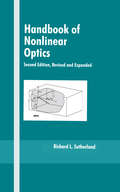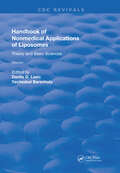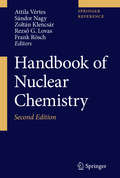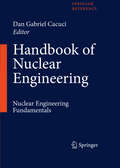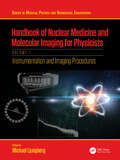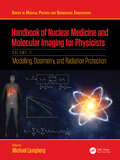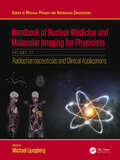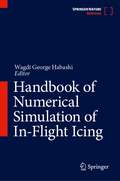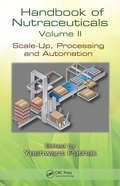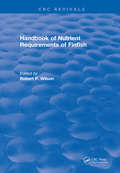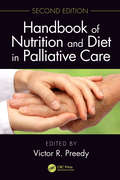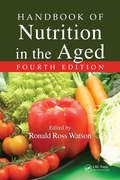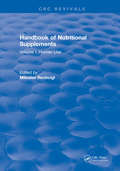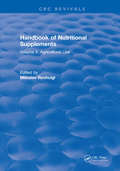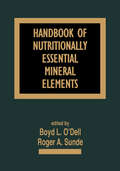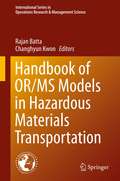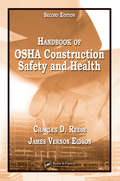- Table View
- List View
Handbook of Nonlinear Optics
by Richard L. SutherlandExamining classic theories, experimental methods, and practical formulas for exploration of the core topics in nonlinear optics, the second edition of this acclaimed text was extensively revised to reflect recent advances in the analysis and modification of material properties for application in frequency conversion, optical switching and limiting,
Handbook of Nonmedical Applications of Liposomes: Theory and Basic Sciences (Routledge Revivals #1)
by Danilo D. Lasic Yechezkel BarenholzFirst published in 1996, liposomes have become an important model in fundamental biomembrane research, including biophysical, biochemical, and cell biological studies of membranes and cell function. They are thoroughly studied in several applications, such as drug delivery systems in medical applications and as controlled release systems, microencapsulating media, signal carriers, support matrices, and solubilizers in other applications. While medical applications have been extensively reviewed in recent literature, there is a need for easily accessible information on applications for liposomes beyond pharmacology and medicine. The Handbook of Nonmedical Applications of Liposomes fills this void.This unique new handbook series presents recent developments in the use of liposomes in many scientific disciplines, from studies on the origin of life, protein function, and vesicle shapes, to applications in cosmetics, diagnostics, ecology, bioreclamation, and the food industry. In these volumes many of the top experts contribute extensive reviews of their work.
Handbook of Nuclear Chemistry
by Attila Vértes Frank Rösch Sándor Nagy Rezso György Lovas Zoltán KlencsárThis revised and extended 6 volume handbook set is the most comprehensive and voluminous reference work of its kind in the field of nuclear chemistry. The Handbook set covers all of the chemical aspects of nuclear science starting from the physical basics and including such diverse areas as the chemistry of transactinides and exotic atoms as well as radioactive waste management and radiopharmaceutical chemistry relevant to nuclear medicine. The nuclear methods of the investigation of chemical structure also receive ample space and attention. The international team of authors consists of scores of world-renowned experts - nuclear chemists, radiopharmaceutical chemists and physicists - from Europe, USA, and Asia. The Handbook set is an invaluable reference for nuclear scientists, biologists, chemists, physicists, physicians practicing nuclear medicine, graduate students and teachers - virtually all who are involved in the chemical and radiopharmaceutical aspects of nuclear science. The Handbook set also provides further reading via the rich selection of references.
Handbook of Nuclear Engineering
by Dan Gabriel CacuciThe Handbook of Nuclear Engineering is an authoritative compilation of information regarding methods and data used in all phases of nuclear engineering. Addressing nuclear engineers and scientists at all academic levels, this five volume set provides the latest findings in nuclear data and experimental techniques, reactor physics, kinetics, dynamics and control. Readers will also find a detailed description of data assimilation, model validation and calibration, sensitivity and uncertainty analysis, fuel management and cycles, nuclear reactor types and radiation shielding. A discussion of radioactive waste disposal, safeguards and non-proliferation, and fuel processing with partitioning and transmutation is also included. As nuclear technology becomes an important resource of non-polluting sustainable energy in the future, The Handbook of Nuclear Engineering is an excellent reference for practicing engineers, researchers and professionals.
Handbook of Nuclear Medicine and Molecular Imaging for Physicists: Instrumentation and Imaging Procedures, Volume I (Series in Medical Physics and Biomedical Engineering)
by Michael LjungbergThis state-of-the-art handbook, the first in a series that provides medical physicists with a comprehensive overview into the field of nuclear medicine, is dedicated to instrumentation and imaging procedures in nuclear medicine. It provides a thorough treatment on the cutting-edge technologies being used within the field, in addition to touching upon the history of their use, their development, and looking ahead to future prospects. This text will be an invaluable resource for libraries, institutions, and clinical and academic medical physicists searching for a complete account of what defines nuclear medicine. The most comprehensive reference available providing a state-of-the-art overview of the field of nuclear medicine Edited by a leader in the field, with contributions from a team of experienced medical physicists Includes the latest practical research in the field, in addition to explaining fundamental theory and the field's history
Handbook of Nuclear Medicine and Molecular Imaging for Physicists: Modelling, Dosimetry and Radiation Protection, Volume II (ISSN)
by Michael LjungbergMathematical modelling is an important part of nuclear medicine. Therefore, several chapters of this book have been dedicated towards describing this topic. In these chapters, an emphasis has been put on describing the mathematical modelling of the radiation transport of photons and electrons, as well as on the transportation of radiopharmaceuticals between different organs and compartments. It also includes computer models of patient dosimetry. Two chapters of this book are devoted towards introducing the concept of biostatistics and radiobiology. These chapters are followed by chapters detailing dosimetry procedures commonly used in the context of diagnostic imaging, as well as patient-specific dosimetry for radiotherapy treatments. For safety reasons, many of the methods used in nuclear medicine and molecular imaging are tightly regulated. Therefore, this volume also highlights the basic principles for radiation protection. It discusses the process of how guidelines and regulations aimed at minimizing radiation exposure are determined and implemented by international organisations. Finally, this book describes how different dosimetry methods may be utilized depending on the intended target, including whole-body or organ-specific imaging, as well as small-scale to cellular dosimetry.This text will be an invaluable resource for libraries, institutions, and clinical and academic medical physicists searching for a complete account of what defines nuclear medicine. The most comprehensive reference available providing a state-of-the-art overview of the field of nuclear medicine Edited by a leader in the field, with contributions from a team of experienced medical physicists, chemists, engineers, scientists, and clinical medical personnel Includes the latest practical research in the field, in addition to explaining fundamental theory and the field's history
Handbook of Nuclear Medicine and Molecular Imaging for Physicists: Radiopharmaceuticals and Clinical Applications, Volume III (Series in Medical Physics and Biomedical Engineering)
by Michael LjungbergThis state-of-the-art handbook, the third and final in a series that provides medical physicists with a comprehensive overview into the field of nuclear medicine, focuses on highlighting the production and application of radiopharmaceuticals. With this, the book also describes the chemical composition of these compounds, as well as some of the main clinical applications where radiopharmaceuticals may be used. Following an introduction to the field of radiopharmacy, three chapters in this book are dedicated towards in-depth descriptions of common radionuclides and radiopharmaceuticals used during diagnostic studies utilizing planar/Single Photon Emission Computed Tomography (SPECT) imaging, in addition to during Positron Emission Tomography (PET) imaging, and, finally, radiotherapy. These chapters are followed by those describing procedures relating to quality control and manufacturing (good manufacturing practices) also encompassing aspects such as environmental compliance. Furthermore, this volume illustrates how facilities handling these chemicals should be designed to comply with set regulations. Like many pharmaceuticals, the development of radiopharmaceuticals relies heavily on the use of mouse models. Thus, the translation of radiopharmaceuticals (i.e., the process undertaken to assure that the functionality and safety of a newly developed drug is maintained also in a human context), is covered in a later chapter. This is followed by a chapter emphasising the importance of safe waste disposal and how to assure that these procedures meet the requirements set for the disposal of hazardous waste. Several chapters have also been dedicated towards describing various medical procedures utilizing clinical nuclear medicine as a tool for diagnostics and therapeutics. As physicists may be involved in clinical trials, a chapter describing the procedures and regulations associated with these types of studies is included. This is followed by a chapter focusing on patient safety and another on an imaging modality not based on ionizing radiation – ultrasound. Finally, the last chapter of this book discusses future perspectives of the field of nuclear medicine. This text will be an invaluable resource for libraries, institutions, and clinical and academic medical physicists searching for a complete account of what defines nuclear medicine. The most comprehensive reference available providing a state-of-the-art overview of the field of nuclear medicine Edited by a leader in the field, with contributions from a team of experienced medical physicists, chemists, engineers, scientists, and clinical medical personnel Includes the latest practical research in the field, in addition to explaining fundamental theory and the field's history
Handbook of Numerical Simulation of In-Flight Icing
by Wagdi George HabashiThis Handbook of Numerical Simulation of In-Flight Icing covers an array of methodologies and technologies on numerical simulation of in-flight icing and its applications. Comprised of contributions from internationally recognized experts from the Americas, Asia, and the EU, this authoritative, self-contained reference includes best practices and specification data spanning the gamut of simulation tools available internationally that can be used to speed up the certification of aircraft and make them safer to fly into known icing. The collection features nine sections concentrating on aircraft, rotorcraft, jet engines, UAVs; ice protection systems, including hot-air, electrothermal, and others; sensors and probes, CFD in the aid of testing, flight simulators, and certification process acceleration methods. Incorporating perspectives from academia, commercial, government R&D, the book is ideal for a range of engineers and scientists concerned with in-flight icing applications.
Handbook of Nutraceuticals Volume I: Ingredients, Formulations, and Applications
by Yashwant PathakThe first reference of its kind, this volume analyzes nutraceutical extracts and formulations in a pharmacopoeia-like manner. Introductory chapters provide detailed scientific information on characterization and methods for developing reproducible products, including Good Manufacturing Procedure (cGMP) requirements. All of the individual monographs on more than 175 nutraceuticals follow a unified format. Each is characterized by origin and as many as 17 properties, including non-proprietary names, chemical name, CAS no., and applications. A second section focuses on formulations aimed at specific diseases or disorders. The text also includes chapters on safety and toxicity of nutraceuticals.
Handbook of Nutraceuticals Volume II: Scale-Up, Processing and Automation
by Yashwant Vishnupant PathakDue in part to an absence of universally accepted standardization methods, nutraceuticals and functional foods face regulatory ignorance, marketing incompetence and ethical impunity. Even though many researchers believe that there is a connection between nutraceuticals and functional foods and reduced health care expenses as well as disease prevent
Handbook of Nutraceuticals and Functional Foods
by Robert E.C. Wildman and Richard S. BrunoThe field of functional foods along with their bioactive food components has grown tremendously over the past decades. Often guided by hypothesis-generating epidemiological observations, discoveries from basic science studies and controlled trials in humans have provided critical evidence to help establish an optimal diet that alleviates chronic disease risk. These advances have also driven efforts by the food and nutraceutical industries to establish and market health claims, formulate extra-value foods, and even generate new health foods for human benefit.Handbook of Nutraceuticals and Functional Foods, Third Edition, compiles the data from experts in the field that potentiates the already established credibility of the earlier editions. In its three-section format, it provides an authoritative summary of the prophylactic and/or medicinal benefits of natural foods and their constituents that are linked to favorable health outcomes. Beginning with an overview of the field and associated regulations, each chapter describes the chemical properties, bioactivities, dietary sources, and evidence of these health-promoting dietary constituents.Features:• Summarizes plant- and animal-based functional foods and their bioactive components• New chapters on cannabidiol and scientific, legal, and regulatory considerations; green tea and nutraceutical applications; and herbal nutraceuticals and insulin resistance• Includes information on functional food beverages including coffee, green tea, and dairy milk• Discusses antioxidant and anti-inflammatory activities of vitamin E, anthocyanins and other (poly)phenolic compounds, and carotenoids• Provides an update on the health benefits and requirements of protein and performance and therapeutic application and safety of creatine.
Handbook of Nutraceuticals and Natural Products
by Preetha Balakrishnan Sreerag GopiAn essential treatment of nutraceuticals and natural products, their preparation techniques, and applications In Handbook of Nutraceuticals and Natural Products: From Concepts to Application, a team of distinguished researchers delivers a one-stop resource describing the preparation techniques and functional uses of nutraceuticals and natural products with a focus on the technologies involved. The book includes coverage of the biological, medicinal, and nutritional properties and applications of functional foods, as well as the advanced technologies used in the extraction and functionalization of nano components and the nanomaterial and nanochemical aspects of the products. The authors discuss developmental research as well as user-level benefits of nutraceuticals and natural products and thoroughly review the market analyses, quality assurance processes, and regulations relevant to nutraceuticals and natural products. They also cover: Thorough introductions to nutraceuticals, functional foods, liposomal technology, prebiotics, and lycopene and its active drug delivery Comprehensive explorations of nutraceutical compounds from marine microalgae and poly lysine as an antimicrobial agent Practical discussions of a nutraceuticals approach to treating cancer-cachexia and early life nutrition and epigenetics In-depth examinations of encapsulation and delivery of nutraceuticals and bioactive compounds by nanoliposomes and tocosomes as promising nanocarriersPerfect for chemists, biochemists, food scientists, and materials scientists, Nutraceuticals and Natural Products: From Concepts to Application will also earn a place in the libraries of medical scientists working in academia or industry, as well as nutritionists, dietitians, and biochemistry graduate students studying nutraceuticals.
Handbook of Nutrient Requirements of Finfish (CRC Press Revivals)
by Robert P. WilsonA one-of-a-kind book for researchers interested in finfish nutritionHandbook of Nutrient Requirements of Finfish provides a summary of qualitative and quantitative nutrient requirements for almost all cultured finfish for which a significant amount of nutritional information now exists. Information is presented by species and includes how each species is cultured, an index of production, regional locations where each species is being cultured, examples of purified or test diets and special conditions required for laboratory studies, nutrient requirements and practical diet formulation. Discussions of special diets and feeding practices are included for certain species. This book will be a useful guide for students, researchers, practicing nutritionists, aquaculturists, and feed manufacturers interested in fish nutrition.
Handbook of Nutrition and Diet (Food Science and Technology)
by Babasaheb B. DesaiThis handbook of nutrition and diet provides information on food nutrients and their functions; food safety and distribution; food composition, consumption and utilization; adequacy of diet; and the nutritional management of diseases and disorders. It also discusses the effects of nutrition and diet on diseases of the bones, teeth, hair, kidneys, l
Handbook of Nutrition and Diet in Palliative Care, Second Edition
by Victor R. PreedyHandbook of Nutrition and Diet in Palliative Care, Second Edition, is a comprehensive guide, providing exhaustive information on nutrition and diet in terminal and palliative care. It covers physical, cultural and ethical aspects, bridging the intellectual divide in being suitable for novices and experts alike. Following in the tradition of its predecessor, chapters contain practical methods, techniques, and guidelines along with a section on applications to other areas of palliative care. Each chapter features key facts highlighting important areas, summary points, and ethical issues. FEATURES • Use of cannabinoids in palliative nutrition care • Pain control in palliative care • Communications in palliative/end-of-life care: aspects of bad news • Anorexia in cancer: appetite, physiology, and beyond • Palliative care in severe and enduring eating disorders • Linking food supplementation and palliative care in HIV • Eating-related distress in terminally ill cancer patients and their family members • Palliative care of gastroparesis • Preoperative nutrition assessment and optimization in the cancer patient • Childhood leukemia, malnutrition, and mortality as components of palliative care • End-of-life decisions in persons with neurodevelopmental disorders • Resources: listing web sites, journals, books and organizations
Handbook of Nutrition and Food
by David Heber Johanna T. Dwyer Carolyn D. BerdanierThe new edition of the Handbook of Nutrition and Food follows the format of the bestselling earlier editions, providing a reference guide for many of the issues on health and well being that are affected by nutrition. Completely revised, the third edition contains 20 new chapters, 50 percent new figures. A comprehensive resource, this book is a reference guide for many of the issues on health and well being that are affected by nutrition. Divided into five parts, the sections cover food, including its composition, constituents, labeling, and analysis; nutrition as a science, covering basic terminology, nutritional biochemistry, nutrition and genetics, food intake regulation, and micronutrients; nutrient needs throughout the human life cycle; assessment of nutrient intake adequacy; and clinical nutrition, from assessments to a wide variety of disease and health topics.
Handbook of Nutrition in the Aged
by Ronald Ross WatsonDetailed Review of Nutritional Therapies Used to Combat Elderly Health IssuesThe combination of the aging baby-boomer generation and their increased longevity has been fortunately met with increased research and greater understanding of health promotion and disease prevention in the elderly. Handbook of Nutrition in the Aged: Fourth Edition shares
Handbook of Nutritional Supplements: Volume I: Human Use (Crc Series In Nutrition And Food)
by Miloslav RechciglThe Handbook is composed of two parts, the first volume covering supplements for human usewhile the second volume is devoted to agriculture supplements. This volume, relating to food supplements for human use, is organized on the basis of raw materials utilized in their production, as well as on the basis of target groups for which they are intended.
Handbook of Nutritional Supplements: Volume II, Agricultural Use
by Miloslav RechciglThe Handbook is composed of two parts, the first volume covering supplements for human usewhile the second volume is devoted to agriculture supplements. This volume, relating to agriculture supplements, covers various food byproducts and nutritional and other food supplements used in animal feeding. In addition, it also includes information on nutrition supplements for plants.
Handbook of Nutritionally Essential Mineral Elements (Clinical Nutrition in Health and Disease)
by Boyd L. O’Dell Roger A. Sunde"Offers comprehensive, definitive information on all of the essential mineral elements--focusing on biochemical and physiological processes. Describes in detail the function of the nutritionally necessary elements revealed through the latest techniques in molecular biology as well as traditional research methods."
Handbook of Nuts: Herbal Reference Library (Herbal Reference Library #4)
by James A. DukeOver one hundred of the world's most important species of nuts are systematically accounted for in this informative handbook. The text defines nuts and discusses their economic and nutritional value. For easy reference, there is an illustrated account of each nut by species, arranged alphabetically by scientific name. Each account includes the family name, several colloquial names, and paragraphs on uses, folk medicine, chemistry, germplasm, distribution, ecology, cultivation, harvesting, yields, energy, and biotic factors.Chapters Describe:UsesFolk medicineChemistryGermplasmDistributionEcologyCultivationHarvestingYields and economicsEnergyBiotic factors
Handbook of OR/MS Models in Hazardous Materials Transportation
by Rajan Batta Changhyun KwonThe Pipeline and Hazardous Materials Safety Administration of the U.S. Department of Transportation defines hazardous materials (hazmat) as a substance or material capable of posing an unreasonable risk to health, safety, or property when transported in commerce. Hazmat accidents can result in significant impact to the population (death, injuries) and damage to the environment (destroyed or damaged buildings and infrastructure). Further, hazmat, especially explosive materials, can potentially be used by terrorists to attack civilians or to destroy critical infrastructure. This handbook provides models from Operations Research and Management Science that study various activities involving hazmat transportation: risk assessment, route planning, location decisions, evacuation planning, and emergency planning for terrorist attacks. There are two important research areas in hazmat transportation that are widely studied in the literature: risk assessment and shipment planning. In the risk assessment area, important issues include measurement of accident probabilities and consequences in hazmat transport. Example works in the risk assessment area include modeling risk probability distribution over given areas, considering hazmat types and transport modes, and environmental conditions. The first half of this handbook covers the two fields of risk assessment and shipment planning, while the second half of this handbook provides useful models and insights on other important issues including location problems for undesirable facilities, network interdiction, terrorist attack, and evacuation.
Handbook of OSHA Construction Safety and Health
by Charles D. Reese James Vernon EidsonA practical guide for eliminating safety and health hazards from construction worksites, the Handbook of OSHA Construction Safety and Health addresses the occupational safety and health issues faced by those working in the construction industry. The book covers a vast range of issues including program development, safety and health program implemen
Handbook of Occupational Safety and Health
by S. Z. MansdorfA quick, easy-to-consult source of practical overviews on wide-ranging issues of concern for those responsible for the health and safety of workers This new and completely revised edition of the popular Handbook is an ideal, go-to resource for those who need to anticipate, recognize, evaluate, and control conditions that can cause injury or illness to employees in the workplace. Devised as a “how-to” guide, it offers a mix of theory and practice while adding new and timely topics to its core chapters, including prevention by design, product stewardship, statistics for safety and health, safety and health management systems, safety and health management of international operations, and EHS auditing. The new edition of Handbook of Occupational Safety and Health has been rearranged into topic sections to better categorize the flow of the chapters. Starting with a general introduction on management, it works its way up from recognition of hazards to safety evaluations and risk assessment. It continues on the health side beginning with chemical agents and ending with medical surveillance. The book also offers sections covering normal control practices, physical hazards, and management approaches (which focuses on legal issues and workers compensation). Features new chapters on current developments like management systems, prevention by design, and statistics for safety and health Written by a number of pioneers in the safety and health field Offers fast overviews that enable individuals not formally trained in occupational safety to quickly get up to speed Presents many chapters in a "how-to" format Featuring contributions from numerous experts in the field, Handbook of Occupational Safety and Health, 3rd Edition is an excellent tool for promoting and maintaining the physical, mental, and social well-being of workers in all occupations and is important to a company’s financial, moral, and legal welfare.
Handbook of Occupational Safety and Health (Human Factors and Ergonomics)
by Danuta KoradeckaOccupational safety and health- safe work in a safe environment. The challenge, of course, is how to make this happen and make it happen economically. A comprehensive study presenting the state of the art in the field, Handbook of Occupational Safety and Health provides a wide range of methods along with specific criteria for assessing hazard and e
